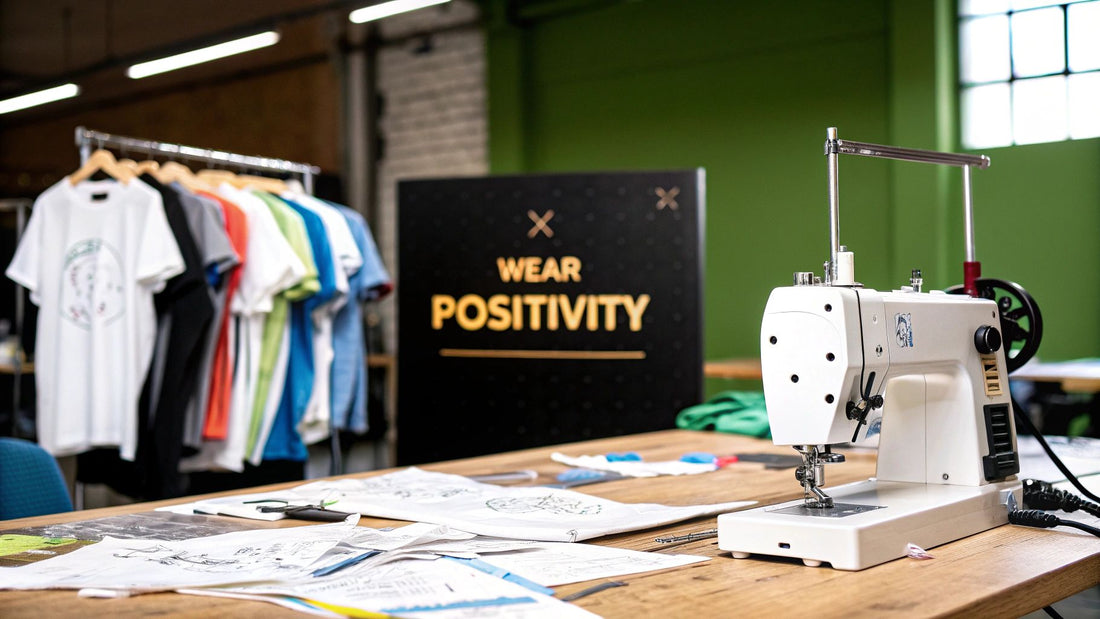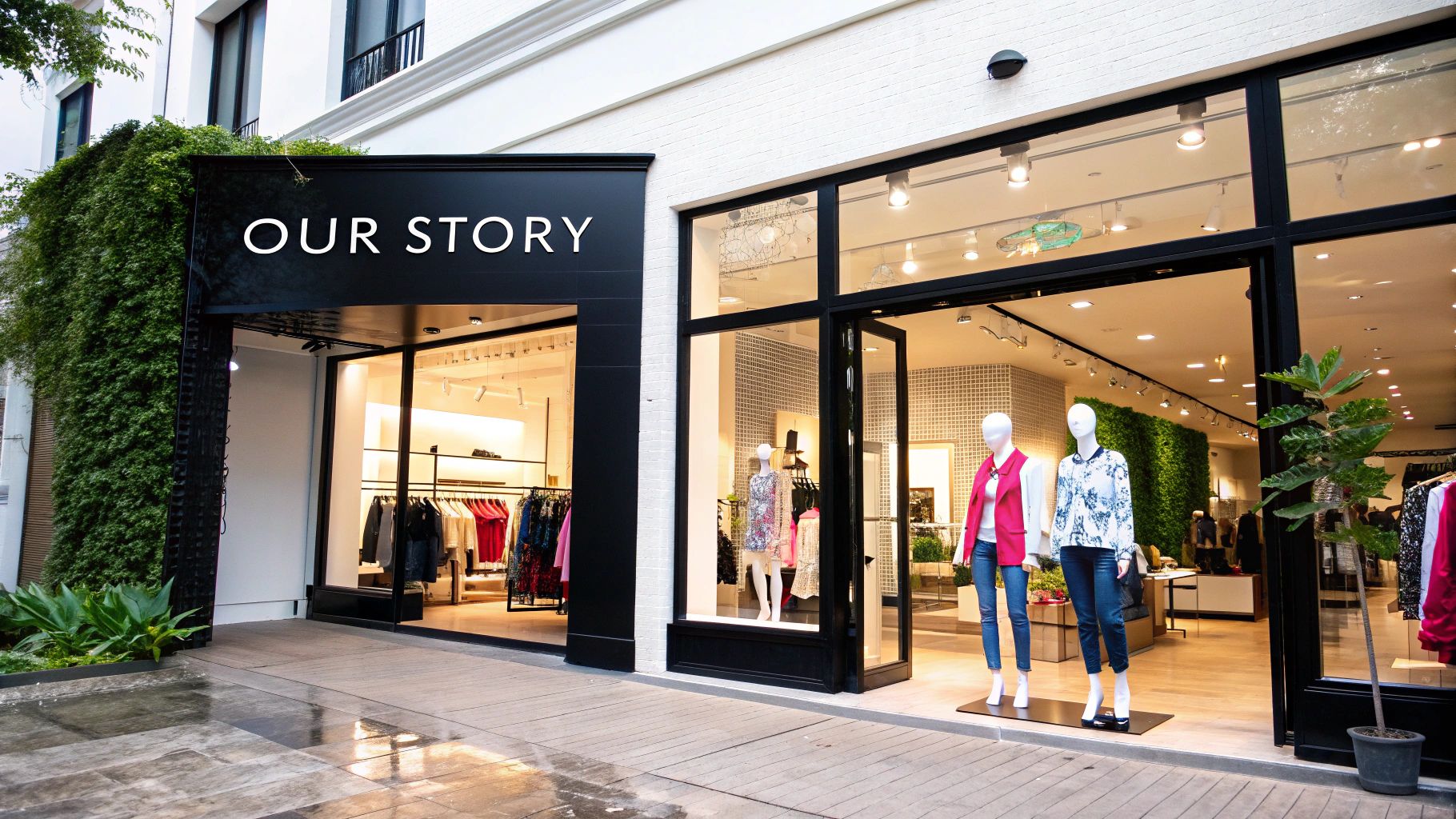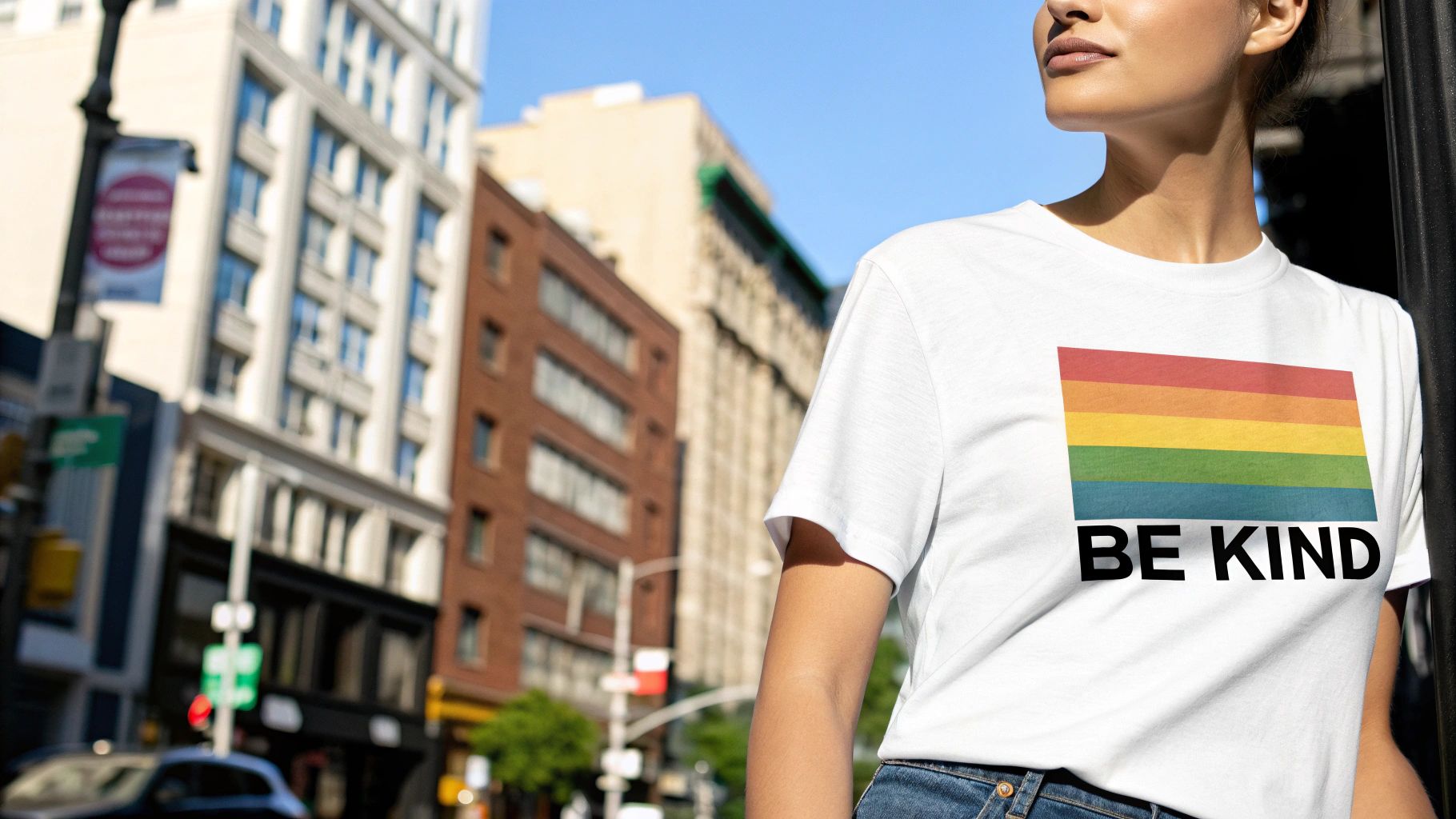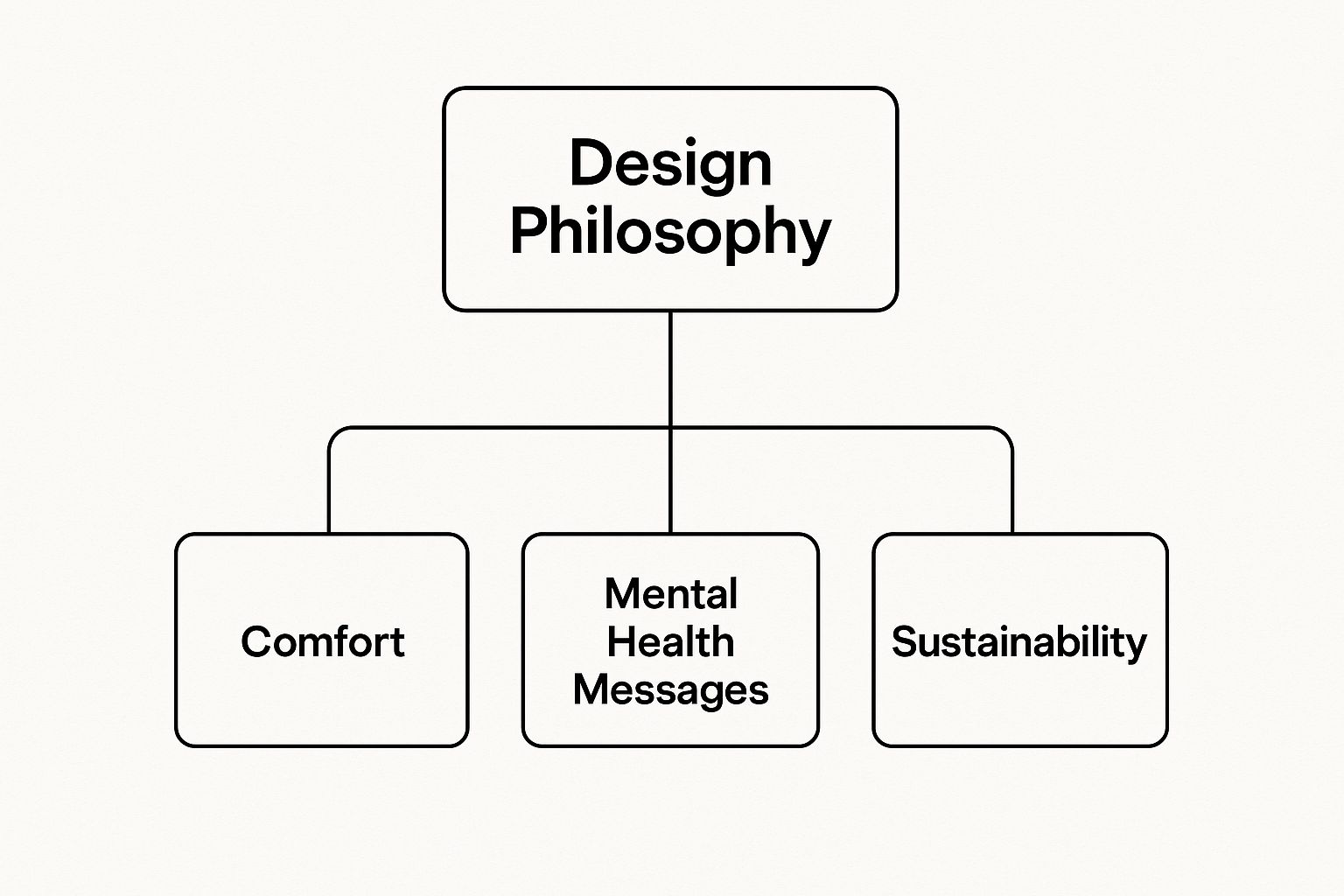
Your Guide to a Mental Health Clothing Brand
Share
A mental health clothing brand is so much more than just another fashion label. Think of it as a movement, a way to chip away at the stigma surrounding mental health challenges, one t-shirt at a time. These brands design clothes with uplifting messages, positive affirmations, and thoughtful images that act as wearable conversation starters. They're symbols of support, turning everyday clothing into a powerful tool for advocacy.
The importance of addressing mental health cannot be overstated. Open conversations help to reduce stigma, encourage people to seek help, and create a more compassionate society for everyone, especially for younger generations who are navigating an increasingly complex world.
What Defines a Mental Health Clothing Brand

Unlike your typical high-street shop, a mental health clothing brand isn't just about looking good. It's built around a core mission that runs much deeper. The main goal is to build a community, raise awareness, and create a visible reminder that nobody has to go through their struggles alone. It’s advocacy you can literally wear on your sleeve.
The importance of this mission is hard to overstate. Mental health issues have a massive impact, not just on individuals but on the whole of society. In fact, poor mental health costs UK businesses an estimated £56 billion a year in lost productivity and sick days. That number alone shows just how badly we need more open, supportive conversations in every part of our lives – including our wardrobes.
Fostering Early Conversations
Getting these conversations started early is crucial. With around one in six children in the UK experiencing a mental health problem, normalising these discussions from a young age is essential. Mental health apparel provides a really gentle and approachable way to do just that.
A t-shirt with a simple message like "It's Okay Not to Be Okay" can open up a dialogue between a parent and child, making abstract feelings feel a bit more real and manageable. For example, a child wearing such a top might be more inclined to talk about a tough day at school, using the message as a prompt. It’s a soft entry point into bigger topics, helping to build a foundation of emotional literacy that can last a lifetime.
A Disclaimer on Professional Help
It’s really important for me to be clear: I am not a mental health professional. While mental health clothing, relaxation tips, and supportive books are all fantastic tools for promoting wellbeing, they are never a substitute for professional medical advice.
If you or someone you know is worried about their mental health, please reach out to a doctor or another qualified professional for help. It is the most important step you can take.
When you're ready to build your own brand's community online, getting the tech right is key. Understanding the essential Shopify apps for clothing brands can make a huge difference in managing your shop and connecting with your customers.
The Movement Towards Fashion with Purpose

Something interesting is happening in the world of fashion. We’re seeing a big shift, especially with younger generations here in the UK. People are no longer just buying clothes; they’re investing in brands that actually stand for something.
This move towards 'conscious consumerism' is all about using what we buy to express who we are and what we believe in. It’s not enough for a product to just look good anymore—it needs to do good, too. This change in mindset has paved the way for the mental health clothing brand to really find its place and make a difference.
Pulling on a t-shirt or hoodie with a positive message is a surprisingly powerful act. It serves as a personal reminder to look after your own wellbeing, while also being a public statement of support for others. This simple blend of style and substance can turn an everyday outfit into a conversation starter and a tool for connection.
The Driving Force of Conscious Consumers
This isn't just a feeling; the numbers back it up. Recent data shows a real appetite among UK shoppers for products linked to mental health. In a 2022 survey, a huge number of people said they were 'very likely' to buy items designed to support wellbeing.
This is especially true for younger shoppers. Around 70% of Millennials and Gen Z have said they would purchase mental health-related merchandise. It shows that for many, a brand’s mission is now just as important as the products it sells. People are actively looking for authenticity and want to put their money behind businesses that are making a positive impact.
Choosing to wear mental health apparel is a quiet act of rebellion against stigma. It’s a way of saying, "My wellbeing matters, and so does yours," without speaking a single word.
If you’re curious about how these clothes can create positive change, our article on mental health t-shirts promoting awareness dives deeper into the topic. It’s a tangible way to support a cause you care about, feel like part of a community, and wear your values on your sleeve—literally.
How This Apparel Creates Real-World Impact
You’d be surprised what a simple t-shirt can do. It’s far more than just a piece of clothing; apparel from a mental health clothing brand creates a tangible, real-world impact that you can feel on a personal, social, and even financial level.
For the person wearing it, a positive affirmation is a gentle, daily nudge to look after yourself. Catching a glimpse of a message like "Be Kind To Your Mind" in the mirror can subtly shift your focus for a moment, inviting a bit of self-compassion into your day. It’s a quiet but powerful way to reinforce healthier thought patterns and take ownership of your wellbeing.
The infographic below really gets to the heart of the philosophy behind designing this kind of meaningful apparel.

As you can see, a thoughtful brand sees comfort, messaging, and sustainability not as separate boxes to tick, but as interconnected parts of its mission.
The impact of this clothing ripples outwards, touching individuals, communities, and even the broader mental health support system. We can break this down into three distinct levels.
Three Levels of Impact from Mental Health Apparel
| Type of Impact | Description | Example |
|---|---|---|
| Personal Impact | Provides the wearer with a personal, visual reminder to practise self-compassion and prioritise their mental health. | Seeing a message like "It's Okay Not to Be Okay" can be a comforting anchor during a tough day. |
| Social Impact | Acts as a conversation starter, helping to break down stigma and normalise discussions around mental wellbeing. | A stranger might comment on a hopeful message on a hoodie, opening the door for a supportive chat. |
| Financial Impact | Many brands donate a percentage of their profits to mental health charities, funding crucial support services. | Purchasing a t-shirt directly contributes to organisations that provide counselling or crisis support. |
Each level builds on the last, turning a simple clothing choice into a multi-faceted statement of support and awareness.
Sparking Conversations and Reducing Stigma
The social impact is where this apparel really comes into its own. Wearing a sweatshirt with a mental health message creates a ripple effect, sparking conversations with friends, family, or even strangers in a coffee shop. It’s a visible signal that you’re a safe person to talk to, helping to chip away at the public stigma that so often stops people from reaching out for help.
Of course, the visual elements are critical here. Finding genuinely impactful t-shirt graphics can really amplify a brand's mission and make the message resonate.
This trend is becoming a noticeable part of the UK clothing market, and it’s not just a fad. Many of these brands are also committed to making a financial difference by donating a portion of their profits to vital mental health charities. For example, Happiness Project gives 15% of their profits to charity, while others team up with organisations like The Jed Foundation to fund essential support services.
Important Disclaimer: Please remember, I am not a mental health professional. This apparel is a tool for support and awareness, not a substitute for professional care. If you have concerns about your mental wellbeing, it is crucial to consult a doctor or a qualified therapist. They can provide the dedicated support you need.
Real Brands Making a Difference
It’s one thing to talk about the idea, but it’s another to see it in action. Plenty of brands out there are genuinely making a difference in the mental health space, from big high-street names to tiny independent labels. They’re a perfect example of what an effective mental health clothing brand can look like, using their platform not just to sell clothes, but to stand for something and build a real community.
Take the collaboration between British fashion giant boohoo and Pantone, for example. For Mental Health Awareness Month, they launched a whole collection based on mood-boosting colours, hoping to help people find an emotional connection with what they wear. The idea really hit home. Data showed that 90% of their customers believe talking about mental health is important, which is a touch higher than the national average. You can dig into that customer sentiment more over on YouGov.
Independent Voices with Personal Stories
Beyond the big names, some of the most powerful brands are born from incredibly personal experiences. Founders who have been through their own mental health journeys often create labels that feel completely authentic. They aren’t just hopping on a trend; they’re sharing their story and offering the kind of support they wish they’d had.
These smaller, independent brands often zero in on specific messages that connect with niche communities. Their designs might be more understated or feature unique affirmations that come from a real, lived-in place, which creates an incredibly strong bond with their customers.
What Makes a Brand Genuinely Stand Out?
So, how can you tell a truly dedicated brand from one that’s just paying lip service? It really comes down to a few core things:
- Transparency: They’re upfront about their mission. If they’re working with charities, they’re clear about how much they donate and who they support.
- Authentic Messaging: Their slogans and designs feel real and thoughtful, not like something pulled from a generic marketing playbook. You can tell they’re speaking from a place of genuine understanding.
- Community Focus: They don’t just sell products; they build a supportive community around their brand. They use social media to share resources, personal stories, and messages of hope.
If you look for these qualities, you’ll find brands that are genuinely committed to making a positive impact. That way, you know your purchase is supporting the cause in a way that truly matters.
How to Find and Support Authentic Brands

As the conversation around mental health opens up, more and more brands want to join in. While this is brilliant for raising awareness, it can make it tough to spot which companies are genuinely committed and which are just jumping on a trend.
This is sometimes called 'wellbeing washing' – when a business uses mental health messaging for profit without really backing it up. Learning to see the difference is the key to making sure your money supports real, positive change.
An authentic mental health clothing brand will be transparent about its mission, its partnerships, and the impact it’s having. By becoming a more discerning shopper, you can back the brands that are truly making a difference and make choices that feel good.
A Checklist for Authenticity
Before you buy, it’s worth taking a moment to do a little digging. A brand with nothing to hide will make this information easy to find.
- Read Their Mission: Head over to their 'About Us' page. Is there a personal story from the founder? Does the mission feel deeply rooted in mental health advocacy, or is it vague and packed with buzzwords?
- Check for Transparency: If they say they donate to charity, they should be specific about it. Look for the names of their charity partners and the exact percentage or amount donated from each sale.
- Examine Their Messaging: Does the wording on their clothing feel thoughtful and supportive? Genuine brands tend to avoid simplistic slogans that might trivialise mental health, choosing messages that empower and validate instead.
A brand's authenticity shines through in its actions, not just its words. Look for consistent, transparent efforts to support the mental health community beyond just selling products. For instance, do they share resources or create supportive content on social media?
Taking these small steps helps you confidently find and support brands that are genuinely invested in wellbeing. Our guide to spotting authentic mental health clothing brands has even more tips for making choices that count. Your support can help true advocates continue their vital work.
Building Your Complete Wellbeing Toolkit
Wearing a piece of clothing with a positive message is a fantastic daily reminder, but it's just one tool in a much bigger toolkit. Think of it as a friendly boost. Real, lasting wellbeing comes from building up a collection of resources that support you from the inside out, working hand-in-hand with the positive messages you wear on the outside.
A brilliant place to start is by expanding your knowledge. So many influential mental health books can offer fresh perspectives and genuinely practical strategies for looking after your emotional health. Books like Reasons to Stay Alive by Matt Haig or The Body Keeps the Score by Bessel van der Kolk can be incredibly empowering, helping you understand your own mind better.
Simple Techniques for Daily Calm
Beyond books, simple, actionable relaxation tips can make a world of difference when you're navigating daily stress. You don't need any special gear or loads of time, just a few moments to yourself.
- Mindful Breathing: Take a slow breath in for a count of four, hold it gently for four, and then breathe out slowly for a count of six. It’s a simple exercise that can calm your nervous system almost instantly, and you can do it anywhere.
- The 5-4-3-2-1 Method: When things feel a bit much, ground yourself in the present moment. Name five things you can see, four things you can feel, three things you can hear, two things you can smell, and one thing you can taste.
Navigating the Digital World
Social media can be a tricky one, can't it? While it’s great for connecting with people, its curated nature can also negatively impact our mental health if we're not careful. A key part of modern self-care is learning to curate a more positive digital space for yourself. Don't be afraid to unfollow accounts that make you feel like you're not enough, and actively seek out creators who share uplifting, supportive, and realistic content.
Disclaimer: Please remember, I am not a mental health professional. These tips and resources are for support and are not a substitute for professional medical advice. If you are worried about your mental health, it is essential to seek help from a doctor.
Building a well-rounded approach means combining that internal work with your external expression. You can explore more about the power of clothing in enhancing mental wellbeing in our related article.
Your Questions, Answered
Jumping into the world where advocacy meets apparel can bring up a few questions. It’s a new space for many, so let's clear up some of the most common things people ask about the mental health clothing movement.
Is This Clothing a Substitute for Therapy?
In a word, no. It’s so important to see this kind of apparel for what it truly is: a powerful tool for support, a great conversation starter, and a bit of personal encouragement you can wear. But it is never a replacement for professional mental health care.
If you're struggling or feel worried about your mental health, the most crucial step is to speak with a doctor or a qualified therapist. They can offer the dedicated, professional support you need to navigate what you're going through.
How Can I Tell if a Brand Is Genuinely Making a Difference?
This is a great question. You’ll want to look for two key things: transparency and authenticity. A brand that’s genuinely in this for the right reasons will be open about its mission and any partnerships it has with charities.
Have a look around their website. Do they clearly state which organisations they support? Do they mention what percentage of their profits goes to the cause? A real advocacy brand’s messaging should also feel thoughtful and considered, not like a generic marketing slogan slapped on a t-shirt.
I Want to Start My Own Brand. What’s the First Step?
Before you even think about designs or fabrics, the very first and most important step is to define your mission. Ask yourself: Why do I want to start this brand? What’s my story?
A truly powerful advocacy brand is built on a foundation of an authentic story and a clear, heartfelt purpose. This core mission will become your north star, guiding every single decision you make down the line, from the designs you create to the partners you choose to work with.
